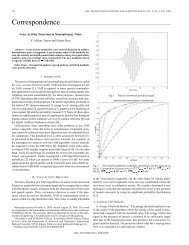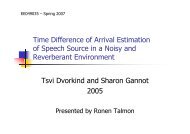Thesis (PDF) - Signal & Image Processing Lab
Thesis (PDF) - Signal & Image Processing Lab
Thesis (PDF) - Signal & Image Processing Lab
Create successful ePaper yourself
Turn your PDF publications into a flip-book with our unique Google optimized e-Paper software.
4.3. FILTERING USING A COMBINED METHOD 55<br />
4.3 Filtering using a combined method<br />
It is possible to combine the features of the above two methods into a single method.<br />
We can still look at all multiple path combinations and find such a combination that<br />
results in the largest adapted SE and a longest alternating sequence. An example is<br />
given in Fig. 4.13.<br />
4.4 Results Comparison<br />
4.4.1 Comparison of different methods for avoiding trenches<br />
In this section, we summarize the comparison between different methods for solving<br />
the trench problem. Figs. 4.14(c),(d) show the trench problem in BTV-based erosion<br />
ˆεB and opening ˆγB of the noisy image in Fig. 4.14(b), respectively. Figures 4.15, 4.16<br />
and 4.17 show the results of the three proposed methods. The multiple minimal paths<br />
method is unacceptable, because it leaves trenches. The adaptive structure element<br />
method and combined method results are very similar. The combined method results<br />
are better than those of the adaptive structuring element method, but it is more<br />
complex and more memory consuming.<br />
4.4.2 Filtering of AS images versus traditional morphological<br />
filtering<br />
In this section, filtering results in the Alternating-Sequence inf-semilattice are com-<br />
pared to the traditional erosion, dilation, opening, closing, open-close, close-open<br />
operators in the complete lattice of gray level functions and a median filter.<br />
In the example given in Fig. 4.19, traditional closing removes dark noise pixels,<br />
but not the bright ones, and damages thin dark parts and edges. Traditional opening<br />
removes bright noise, but not dark noise. In contrast, opening that was defined in<br />
inf-semilattice of AS images is self-dual and removes both bright and dark noise.<br />
However, it is possible to perform pseudo self-dual filtering in complete lattice of gray<br />
level functions using traditional open-close or close-open operators, see Fig. 4.20.<br />
The drawback is that such filtering contains two consecutive operations. Opening<br />
removes bright noise, but damages thin bright parts or edges. Closing after opening
















